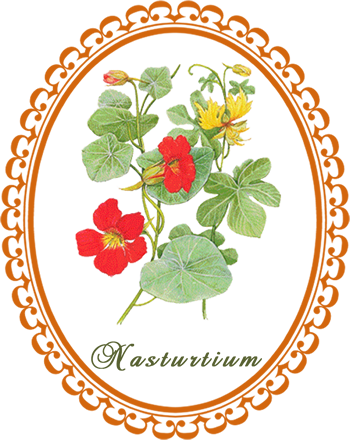
Nasturtium: is said to help to clear skin problems like acne, and also to ease depression ...
Common Names: Nasturtium, Indian Cress, Monks Cress
Botanical Name: Tropaelum majus
Family: Tropaeolaceae
Plant Type: Herbaceous annual vine
Parts Used: Aerial parts
Flowering: May to September
Nasturtium originated in South America in the Andes from Bolivia north to Columbia.
Description: Nasturtium is an herbaceous plant with trailing stems growing to 1 meter long or more. The leaves are large, nearly circular, 3-15 cm in diameter, green to light bluish-green above, paler below; they are shield-shaped, with the leafstock near the middle of the leaf, with several veins radiating to the smoothly rounded or slightly lobed margin. The flowers are 2 - 6 cm diameter, with five petals, eight stamens, and a 2.5–3 cm long nectar spur at the rear; they vary from yellow to orange to red, frilled and often darker at the base of the petals. The fruit is 2 cm broad, three-segmented, each segment with a single large seed 1–1.5 cm long.
Cultivation: Nasturtiums are tender perennials native to South America. In the North they are grown as annuals, in moist, well-drained soil in full sun. The best way to encourage the flame-coloured flowers and not just the greenery is to starve it. A rich soil will produce nothing but leaves.
Harvesting: The flowers and leaves can be picked at any time. Gather the seeds when they are ripe.
Companion Planting: Grow nasturtiums near your tomatoes to keep away whiteflies. Nasturtiums also repel squash bugs and many cabbage pests.
Culinary Uses: Nasturtiums are edible and high in vitamin C. Toss the a few of the leaves and flowers in salads or use the flowers as a garnish. They have a pungent, peppery flavor. The seeds can be pickled and used like capers.
Nasturtium
Vitality
The Nasturtium brings me radiant energy, a glowing vitality
that helps me direct my Soul's light
into the practical experiences of daily life and physical reality.
I now master all my activities to create joy and abundance.
Herbal Healing with Nasturtium
Medicinal Actions: Antimicrobial, laxative (gentle), tonic
Medicinal Uses: Nasturtiums are a potent anti-microbial agent. They are useful in treating respiratory infections such as bronchitis, as well as viral infections such as influenza and the common cold. Its bitterness acts as a tonic to the mucous membranes, helping to clear congestion. Nasturtium is a good digestive tonic, stimulating the flow of juices and acting as a gentle laxative. Use it fresh as a poultice for external infections.
Healing Combinations with Nasturtium
For respiratory infections, it combines well with elder (Sambucus), echinacea (Echinacea) and yarrow (Achillea)
For urinary infections, try it with buchu (Barosma), couch grass (Agropyron), or corn silk (Zea)
If you appreciate the information provided,
please help keep this website running. Blessings!
© 2008-2025 aromaworx.ca. All rights reserved.

